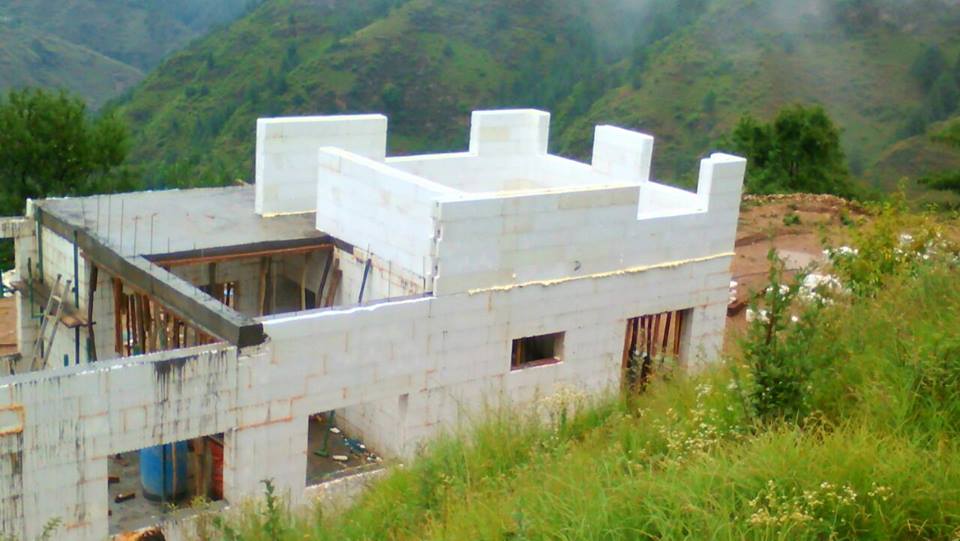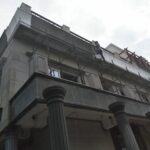The Insulating concrete form or insulated concrete form (ICF) of today is a system of formwork for reinforced concrete made with rigid thermal insulation that stays in place as a permanent interior and exterior substrate for walls, floors, and roof. The forms are interlocking modular units that are dry-stacked (without mortar) like Lego blocks and filled with concrete. These units create a form for the structural walls or floors of a building.
However, they became popular during the 1970s after they came into the panel-like form we are now familiar with. Historically, the structures used to be timber, later followed by heavy-duty thick brick masonry walls (think old Havelis that still exist throughout India).
As space started becoming a constraint, thick masonry walls got replaced by thinner brick walls or stay-in-place structural forms that could be lightweight plastic or flexible concrete formwork. However, these did not have the requisite thermal mass to provide sufficient insulation, which was vital with the changing weather patterns.
The beginning of ICF with cement-bonded wood fiber

Durisol, was the first ICF, developed in Belgium in 1937 by the Swiss nationals August Schnell and Alex Bosshard (Dutch patent registered in 1932.) The forms were made of cement-bonded wood fiber material. In 1938, Durisol AG, registered near Zurich, Switzerland, entered the international markets in the Netherlands, France, and Belgium after World War I – filling the void for a quick, cost-effective, and solid construction method using largely unskilled labor. The first patent for an insulated stay-in-place formwork for concrete was registered in the early 1940s using recycled waste wood and cement as the insulating material. The construction technique further developed in Europe following World War II as an inexpensive and durable way to rebuild damaged structures. Subsequent International patents include The Canadian Patent in May 1953 based on the Swiss Patent Application, 1948 and subsequently Canadian Patent in 1949. By 1959, Durisol was promoted as cutting traditional construction costs by 20-30% and was produced in 13 countries. Therefore, it takes credit for having invented ICFs and being used in construction worldwide for over 80 years.
The first Polystyrene foam ICF

The first polystyrene ICF forms were developed in the late 1960s after the expiry of the original patent and the advent of modern foam plastics. The first patent for a foam concrete form was filed in Canada in 1966, granted 2years later. It was named “Foam Form,” and each block measured 16 inches high by 48 inches long with a tongue-and-groove interlock, metal ties, and a waffle-grid core. The design remained unchanged for the next 15 years.
The first ICF construction was in Ontario, Canada

One of the first ICF block construction projects was a home completed in 1969 in Ontario, Canada, where commercial construction with ICF blocks also began in that same year. BASF, the chemical company to invent EPS in Germany and Dow Chemical in the USA, took steps towards developing materials for ICF-based constructions. Manufacturing units came up in Japan and Germany, USA & Canada by 1971. The adoption of ICF construction picked up after 1970 when panel style ICF was developed and has steadily increased since the design standard, was adopted two decades later.
As builders recognized the benefits of this alternative building material in the 1980s, many new North American ICF companies came up. These began ICF supplies to self-builders, developers, and housing associations across the continent. Some set up manufacturing bases in Europe and began construction in South America, Africa, and Australia. Styrostone Inc., a German-based ICF company, went international in 1991, with several plants in the EU to supply ICF in European markets. In the mid-1990s, ICF producers in America began training thousands of contractors for installing their building systems. The growth rate in the sale of ICF forms increased 50% to 100% every year until 2005, after which it leveled out to 20% – 30% each year.
ICF for Green and Net Zero Buildings

Since 2000, the “Green building” industry continues to grow even amid major economic downturns in the West. ICF producers demonstrated how the attributes of their building systems like energy-conserving, easy & fast installation, small carbon footprint, durability, and low construction waste – make them a perfect green building material, they were able to grow their sale rapidly. Many homes consuming Net Zero Energy or “Passive Houses” were made in several countries. ICF construction is now part of most building codes and accepted in most jurisdictions in the developed world. ICF block is commonly used for the construction of green and sustainable building projects. ICF construction has become commonplace for both low-rise commercial and high-performance residential construction as more stringent energy efficiency and natural disaster-resistant building codes are adopted.
ICF in India (Since 2013)

Styrostone partnered with Reliable Insupacks (RIPL) in 2013 to make India’s first ICF building, a farmhouse in Manesar, near New Delhi. 6no. ICF buildings got constructed between 2014-16 in North India alone. Reliable Building Solutions, a sister concern of Reliable Insupacks (P) Ltd., independently introduced RELIABLE ICF, its building system, together with technical and logistical services, to support the construction of the greenest, highest performing, and most-cost-effective structures in the market today. ICF is the most versatile and high-quality system to construct new buildings. In the future, ICF construction will deliver performance levels in energy efficiency, natural disaster protection, fire resistance, and overall living comfort and health, far superior to what is achieved with frame and concrete block structures.
Approvals in India
BMTPC(Building Material and Technology Promotion Council), under the Central Government Ministry of Housing and Urban Affairs (MOHUA), approved RELIABLE construction material, ICF, in 2017, and there has been no looking back for us since then! We participated in the Global Housing Technology Challenge in 2019. After detailed presentations made to its Technology approval Panel of GHTC, consisting of heads of SPA(School of Planning & Architecture), Delhi, CBRI(Central Building Research Institute), Roorkee, IIT(Indian Institute of Technology), Chennai, and CPWD(Central Public Works Department), ICF got approved as a suitable construction technology for use in PMAY (Pradhan Mantri Awas Yojana), Mass Housing projects. Finally, in 2020, ICF was approved as a “New Technology” for constructing all government buildings in the future.






Pingback: Reliable ICF at GHTC India — Greener, Safer, Stronger, Faster Construction